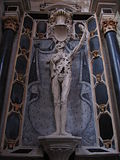Memento mori
Memento mori (Latin for that is that 'remember that you [have to] die'[1]) is an artistic figure of speech. It is a reminder that nobody can avoid death. It has been written on many gravestones.
Memento Mori Media
The outer panels of Rogier van der Weyden's Braque Triptych (c. 1452) show the skull of the patron displayed on the inner panels. The bones rest on a brick, a symbol of his former industry and achievement.
Memento mori. Gravestone inscription (1746). Edinburgh. St. Cuthbert's Churchyard.
Unshrouded skeleton on Diana Warburton's tomb (dated 1693) in St John the Baptist Church, Chester
Philippe de Champaigne's Vanitas (c. 1671) is reduced to three essentials: Life, Death, and Time
Thomas Smith's Self-Portrait
Prince of Orange René of Châlon died in 1544 at age 25. His widow commissioned sculptor Ligier Richier to represent him in the Cadaver Tomb of René of Chalon, which shows him offering his heart to God, set against the painted splendour of his former worldly estate. (Church of Saint-Étienne, Bar-le-Duc)
French 16th/17th-century ivory pendant, Monk and Death, recalling mortality and the certainty of death (Walters Art Museum)
References
- ↑ Literally 'remember (that you have) to die' Archived 2016-08-23 at the Wayback Machine, Oxford English Dictionary, Third Edition, June 2001.
+{{{1}}}−{{{2}}}








